
Thematic Planning•Theory and Practice of Constructing China's Independent Discourse of Literature and Art Criticism (II)
■ Civilizational Dialogue:A New Vision for Constructing China's Independent Discourse System of Literary and Artistic Criticism (PP. 4–17)Cao Shunqing
Abstract: Chinese literary and art criticism has developed its own unique system, characteristics, and discourse, encompassing a wide range of literary and artistic fields such as poetry, painting, calligraphy, music and dance. However, the "sinophilic" and "exclusive Western-centric" worldview that emerged in modern times has overlooked the uniqueness and heterogeneity of Chinese culture. Using Western civilization as the benchmark and Western theories as the meta-discourse has obscured, distorted, and devalued Chinese literary and art criticism, which itself is also a valid theoretical discourse. This article argues that reconstructing an autonomous Chinese literary criticism discourse is primarily about reshaping the worldview, the fundamental prerequisite for all disciplines (including the system of literary and art criticism) to break free from existing Western frameworks and engage in self-reflection and innovation. Reshaping the concept of civilization, and re-examining China's discursive system of literary and art criticism with a vision of intercultural dialogue, and re-presenting the dialogue and mutual construction of Chinese and Western literary criticism discourses "in history," "in the world," and "in civilization," and ultimately realizing an innovative and globally-oriented contemporary Chinese literary criticism discourse, is the key to constructing an autonomous Chinese discursive system for literary and art criticism.
Keywords: concept of civilization, civilizational dialogue, autonomous Chinese knowledge system, discursive system of literary and art criticism, Variation Theory
■ Concerning the Independence of the Discourse of China's Literary Theories from the Qualities of Chinese Aesthetic Tradition (PP. 18–31)He Zhonghua
Abstract: In the rapid progress of modernization, the discursive hegemony of modernity has created a trend of assimilation of narrative methods in Chinese literary theory. It enables us to read from an "other" perspective a meaning that we have never read before, but it also leads to the obscuring of the inherent qualities of the Chinese aesthetic tradition, and the farther-reaching effect is the disappearance of the independence of the Chinese literary discursive system. The basic interest of Chinese culture, which emphasizes recognition and personal testimony, has defined the unique approach and orientation of Chinese literary criticism. Unlike the Western aesthetic tradition, which emphasizes representation, seeks the resemblance in form and favors realistic writing, the classical Chinese aesthetic approach expression, seeks resemblance in spirit and favors freehand brushwork. Chinese aesthetic creation always has a moral load. That is, it plays the function of ethical edification, thus rejecting aestheticism. Chinese culture is essentially an aesthetic and poeticized culture. In dealing with the challenges of modernity, how to maintain and defend the autonomy of Chinese culture is a task we must face up to. Constructing an autonomous discursive system for Chinese literary theory is one of the most important and indispensable aspects.
Keywords: Chinese aesthetic tradition, expression, resemblance in spirit, freehand brushwork, the discourse of Chinese literary theory, autonomy
■ The Constructing Dimensions of the Autonomous Discursive System of Chinese Film and Television Theory and Criticism (PP.32–42)Zhao Weifang
Abstract: The construction of the autonomous discursive system of Chinese film and television theory and criticism is an important proposition for the construction of cultural self-confidence and cultural power in the new era. The four dimensions of national discourse, modern discourse, popular discourse and international discourse are the main dimensions and objectives of the construction of this system. National discourse is mainly manifested in the national values and national aesthetic views in China's system of film and television theory and criticism. Modern discourse is mainly presented in the system's contemporaneity and innovativeness, as well as its balance with Western theories. Popular discourse is mainly reflected in the popularity of the system's production and dissemination. And international discourse is mainly manifested in the system's international discursive power and influence. The above four dimensions are "four in one" and interact with each other in the construction of China's autonomous discursive system of film and television theory and criticism.
Keywords: China's autonomous discursive system of film and television theory and criticism, national discourse, modern discourse, popular discourse, international discourse
■ The Principles, Paths, and Methods for Establishing a Discursive System for Contemporary Xiqu Criticism (PP. 43–51)Zhao Jianxin
Abstract: Contemporary Xiqu (traditional Chinese opera) art has undergone extensive and profound changes in the subject matter, stage style, and dissemination methods of its plays. To construct a discursive system for contemporary Xiqu criticism, it is necessary to base it on "creative transformation" and "innovative development" under the premise of "Two Combinations", based on the historical development and contemporary situation of Xiqu art, grasp the relationship between new Xiqu forms and old traditions in the development of the times, and strive to adhere to the principles of history and dynamics. On the basis of the three paths of integration, practice, and folk culture, it is necessary to try four methods: the combination of commonality and individuality, the combination of text and stage, the combination of internal criticism and external criticism, and interdisciplinary approaches.
Keywords: Xiqu critical system, Xiqu criticism, critical discourse, principle, route, method
■ New Opportunities, Subjective Positions and Global Dialogue:Reflections on Constructing China's Autonomous Discursive System of Design Criticism (PP. 52–61)Zhu Shuai
Abstract: Currently, art-based design scholars are faced with unprecedented challenges and opportunities in the construction of interdisciplinary designology. Art studies, as one aspect of the interdisciplinary fields, should play their important roles and collaborate with engineering-based design scholars. For the art-based design studies, its liberal arts nature is an important part of contemporary Chinese social sciences. Therefore, we urgently need to establish an autonomous knowledge system composed of Chinese characteristic disciplinary system, academic system, and discursive system. In the process of establishing China's autonomous knowledge system of designology, design criticism plays an important role. This article focuses on design criticism and proposes that the construction of China's autonomous discursive system for design criticism will provide useful cases and inspirations for the construction of the "three major systems" of China's designology at the current stage.
Keywords: interdisciplinary, subjectivity, Chinese characteristic, design criticism, discursive system
Theoretical Explorations
■ Philosphical Aesthetic Semantic Analysis of the Yixiang Category (PP. 62–77)Mao Xuanguo
Abstract: "Yixiang" is an important category of philosophical aesthetics, but also a theoretical category that is very prone to linguistic ambiguity. The common confusion is that between the yixiang in the sense of philosophical aesthetics and psychological aesthetics, and the yixiang in the sense of philosophical aesthetics and poetics. This article analyzes this point and, based on this, explores the philosophical aesthetic connotation of the category of imagery. As a category marking the ontological consciousness of philosophical aesthetics, "yixiang" was born in the philosophical background of the unity of heaven and man and the unity of matter and self in ancient China, and it is the embodiment of the thinking of the ancient Chinese who still emphasized yixiang and the embodiment of the poetic cultural spirit of ancient China. Yixiang is thus characterized by the integrate harmony, generativity, transcendence and emotional experience, reflecting the basic characteristics of Chinese aesthetics and art, and at the same time, it can also be used as a category of modern aesthetics and art, entering into the aesthetic vision of modern people.
Keywords: yixiang, philosophical aesthetics, psychological aesthetics, poetics, traditional Chinese aesthetics
■ The Consolidation of Chinese Cultural Subjectivity and the Reconstruction of Literary Ethnicity:Centering on the Discussion of "Ethnic Forms" (PP. 78–91)Cui Hailiang
Abstract: The national form of literature and art is a way of displaying cultural confidence and an important form of consolidating cultural subjectivity. The discussion of "national forms" during the Yan'an period implemented the Chinese Communist Party's ideology of the War of Resistance against Japan and the New Democratic Cultural Program guided the development direction of the discussion of "national forms". Mao Zedong's Talks at the Yan'an Forum on Literature and Art solved the problems of nationalism and class, nationalism and cosmopolitanism, nationalism and popularization, and national form and content involved in the discussion of "national forms", completing the construction of the national character of literature and art. The discussion of "national form" is of great practical significance for the consolidation of the subjectivity of Chinese culture and the reconstruction of the national character of literature and art in the new era. To reconstruct the national character of literature and art in the new era, it is necessary to be guide by Xi Jinping Thought on Culture, stick to the position of Chinese culture, adhere to the people-centered creative orientation, construct a disciplinary system of literature and art with Chinese characteristics, carry forward the spirit of China, unite the power of China, enhance cultural self-confidence, and continuously consolidate the subjectivity of Chinese culture.
Keywords: discussion on "National Forms", subjectivity of Chinese culture, nationality of literary and art, disciplinary system of literature and art with Chinese characteristics
■ "Literature of the New Era":Naming Method, Context of Formation, and Pioneering Development Space (PP. 92–100)Zeng Jun
Abstract: The "Literature of the New Era" represents a time-defined naming approach for literary categories. Unlike the "Literature of the New Period" which signifies a "farewell to the old era", and the "Literature of the New Century" which seeks to establish legitimacy for the new century, "Literature of the New Era" is directed toward "creating the future of the New Era". Its development and overall characteristics are shaped by "the people-centered orientation", the rapidly evolving "contemporaneity" of the technological revolution, and an increasingly prominent "traditionality" forged through intercultural exchange and mutual appreciation. "Literature of the New Era" manifests in a tripartite structure: (1) serious literature that follows the principles of realism and aims to "recreate the epic"; (2) online literature that adapts to emerging internet technologies and seeks to construct grand worldviews; and (3) new media "short literature" that caters to the fast pace of modern life and is designed for interaction and easy dissemination. "Literature of the New Era" is characterized by openness, interactivity, and participation, representing a future-oriented, dynamic, and creative literary form.
Keywords:Literature of the New Era, naming methodology, context of formation, development space
Criticism and Contention
■ Bias of Concept, Dislocation of Standards and Anomie of Discourse:A Critical Reflection on the Lack of the Academic Character of Current Theatre Criticism (PP. 101–110)Mu Hailiang
Abstract:The current theatre criticism is lacking in academic character. Literary-oriented theatre criticism reflects the bias of critical concepts, while the fixed thinking pattern of drama on traditional Chinese opera criticism highlights the dislocation of critical standards. And furthermore, the habitual discourse deviation refracts the anomie of language expression. Reflecting on these issues can help optimize the discursive system of theatre criticism, thus enabling it to truly fulfill its cultural function.
Keywords:theatre criticism, academic character, literary orientation, fixed thinking pattern of drama, loss of discursive norms
Interview with Renowned Experts
A Wonderful Storyteller, Miaolan-Qifang: An Interview with the Quyi Performing Artist Liu Lanfang (PP. 111–124)Interviewed by Lou Yichen
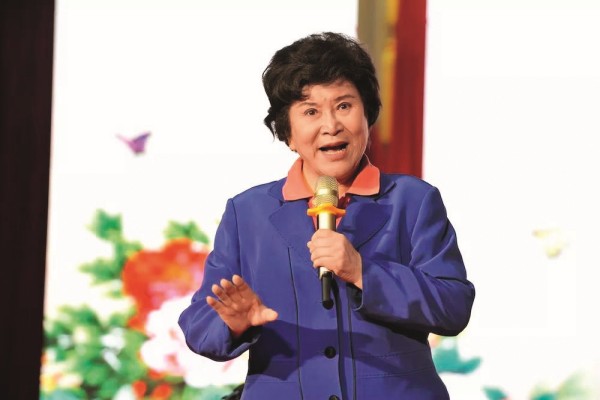
Inside Front Cover
Chinese Literary Critics: Zou Zan
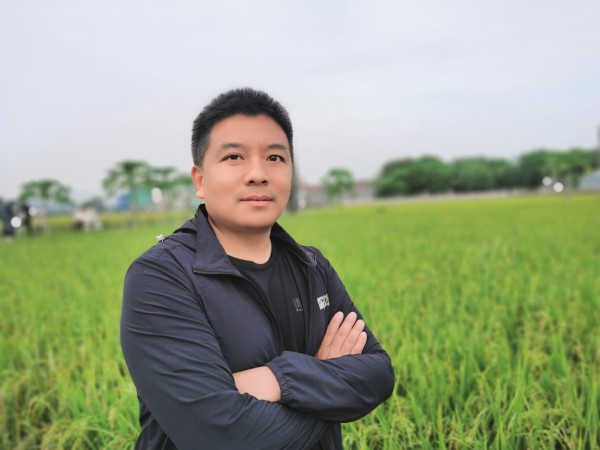
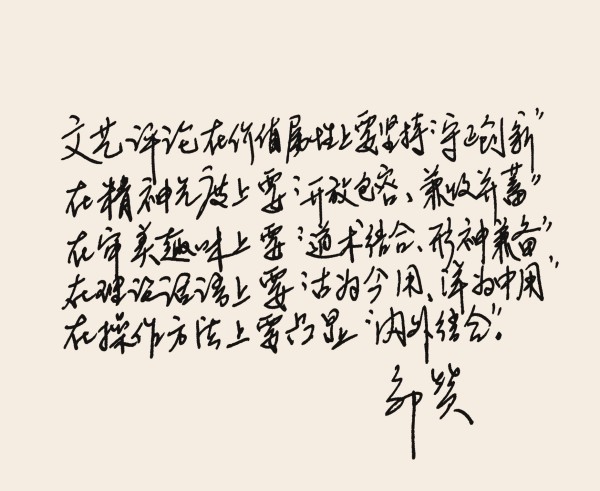
Inside Back Cover
Call for Subscription of Magazine, China Literature and Art Criticism in 2025
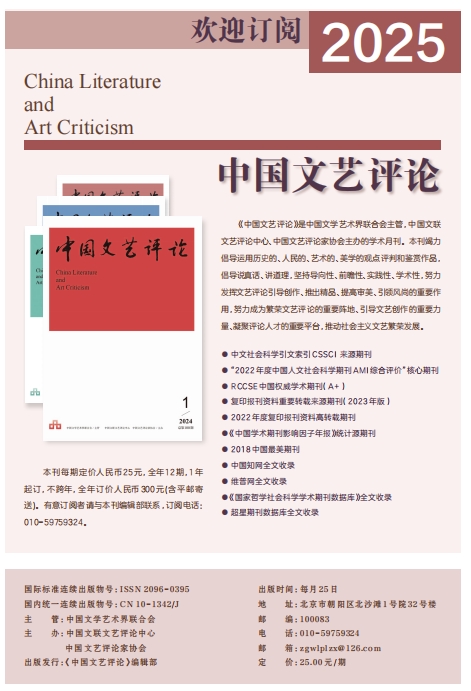
Back Cover
Poster for the Symposium on "Ten Years of Literature and Art Criticism"
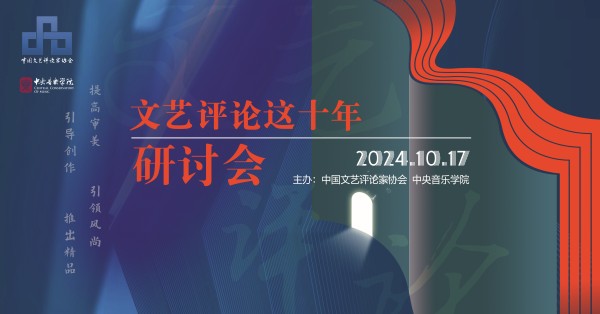


中国文艺评论网

“中国文艺评论”微信公号

“中国文艺评论”视频号